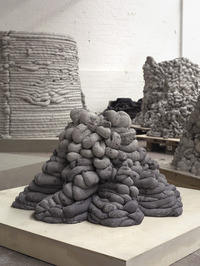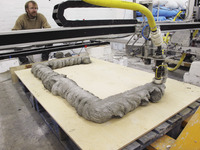 Two years ago we wrote on Contour Crafting’s experiments with building-sized 3D printing, in which they were designing a house-sized 3D printer assembly to extrude concrete into shapes suspiciously resembling buildings. The concept is almost unbelievable, where you could erect most of a house at the push of a button (and a few deliveries of fresh cement). We haven’t seen many further developments since then in the world of concrete printing other than D-Shape’s amazing printed monument.
Two years ago we wrote on Contour Crafting’s experiments with building-sized 3D printing, in which they were designing a house-sized 3D printer assembly to extrude concrete into shapes suspiciously resembling buildings. The concept is almost unbelievable, where you could erect most of a house at the push of a button (and a few deliveries of fresh cement). We haven’t seen many further developments since then in the world of concrete printing other than D-Shape’s amazing printed monument. However today we ran across Factum Arte and Anish Kapoor, who have been experimenting with cement printing for some years. They’re not printing buildings, but instead are focusing on sculptures with a technique that “combines intention with chance and the live properties of the different cement mixes”.
Kapoor has published a book detailing the entire process, entitled “Unconformity and Entropy”, available right here. From the book:
Some three years ago, Adam Lowe and I wondered if it were possible to make a machine that could generate form. The printing machine formed a model for the basis of our thinking. After much trial and error, we found a surprisingly simple way of making a workable engine.Once we had started making objects, a new reality began to emerge. These were objects like no others; they seemed to obscure the border between artifice and event. These are objects that are more akin to natural things than to those made by design.
 One issue we foresee is the weight; moving tons of cement sculpture could be tricky. In the case of printing an onsite building or monument, weight is less important, but for sculptures you simply must print them on a moveable pallet.
One issue we foresee is the weight; moving tons of cement sculpture could be tricky. In the case of printing an onsite building or monument, weight is less important, but for sculptures you simply must print them on a moveable pallet. Be sure to watch the videos that show the rather swift cement printer. It reminds us of a room-sized RepRap. Watch out for that Y-axis!
Via Factum-Arte and Magpie Aesthetic

